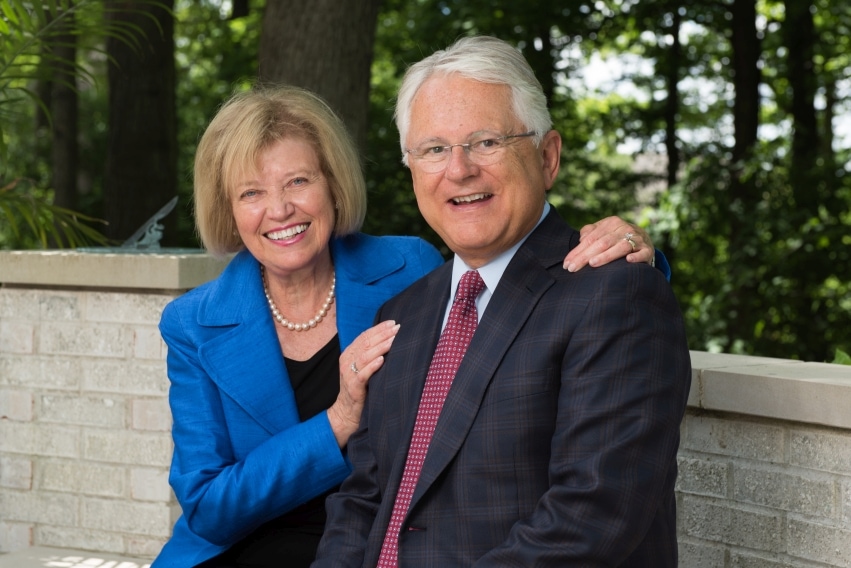Modest, giving, hard-working… These qualities are so engrained in the Midwestern psyche that we often fail to recognize their power. Over the years, Sid and Flo Banwart have quietly worked to make a positive impact on their community, having dedicated their lives to giving—and inspiring others to do the same. The couple’s approach, one of excitement and curiosity, has driven a lifelong love for travel and meeting new people.
Sid, whose career spanned 41 years at Caterpillar, worked his way up from a college internship to serving in four officer positions: Vice President of Research & Product Development; Vice President responsible for the Components Division; Vice President and Chief Information Officer responsible for Systems & Processes; and Vice President and Chief HR Officer responsible for Global Human Services, Public Affairs, Governmental Affairs, Caterpillar Foundation and other administrative areas. Now retired, he is an executive advisor at Challenger, Gray & Christmas, an executive outplacement firm based in Chicago.
As an educator, seamstress and business owner, Flo has enriched the lives of countless others. She has worked for the University of Illinois Extension 4-H program, owned a fabric and sewing shop, taught at Bradley University, and founded numerous sewing groups. Her genuine smile immediately puts you at ease—and while she remains steadfastly humble, the more you get to know her, the more you realize the vast extent of her knowledge and talents. Glancing around their home, you take notice of her intricately crafted quilts, a testament to her artistic acumen and eye for design.
Over the years, the Banwarts have served on many nonprofit boards and given their time and resources to support a plethora of significant community projects. Sid was instrumental in bringing the Caterpillar Visitors Center to life, as well as ensuring the presence of the Peoria Riverfront Museum next door. The couple’s immense philanthropic impact can be felt all over the community, from Big Brothers Big Sisters and the Center for Prevention of Abuse, to the Peoria Symphony Orchestra, WTVP, Junior Achievement and beyond. If you live in the Peoria area, your life has no doubt been enriched by their enduring commitment to charity.
Flo, you grew up on a farm in the small town of Garner, Iowa. Did your family grow crops?
Flo: We did! And livestock—we always had cattle or hogs, and chickens. That was back when you had some of each, although we did focus on cattle for the most part.
Did you have to butcher any of the animals?
Flo: Oh yes, the chickens! [Laughing] My mother was good at it. She would enlist the help of all of us kids. You know, in some ways it was an idyllic childhood. There were all sorts of fun things going on… even if you didn’t think they were so fun at the time.
You received your primary education in a one-room rural schoolhouse. What was that like?
Flo: I had one classmate for my first seven years of education. It was a wonderful experience that was pretty individualized. If you were done with what you had to do, you just sort of eavesdropped and listened to what was going on with the older kids. I think it gave me a real appreciation for education, and for all different kinds of abilities.
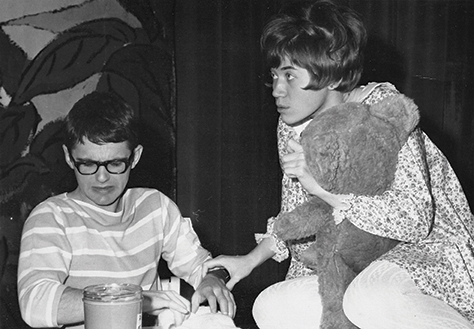
You joined 4-H when you were ten. I know that was a transformative time in your life, as you explored different projects…
Flo: Yes, I loved it. You alternated your focus every year, and girls and boys were taught different things. One year you would be taught cooking, and the next year you would be taught sewing, and then you were taught home furnishings—which was really a fun one! I loved all the doing in 4-H, all of the learning. And if you got to go to the State Fair, that was wonderful.
Was there a particular subject area that you fell in love with?
Flo: I really loved sewing. Ultimately, I ended up in textiles and clothing. Once I got to college, I understood there was more to it than just the technical aspects of putting something together—there was also the design part of it. The applied art curriculum that I got from Iowa State University was an interesting part of my education.
Sid, tell me about your family and childhood. I understand that your great grandfather came out to the prairie in a covered wagon?
Sid: I remember sitting on his lap when I was about five years old, and he was telling me this story about coming out to western Iowa in a covered wagon. I kept saying, “Why?” And he said, “Well, President Garfield had a land grant, which meant we could get free land to farm if we would homestead the land. You had to plow the virgin prairie, build a house and farm the ground for three years—and he would give you a deed to 160 acres.” And he did that. But around my hometown, there were not many trees on the Western prairie. So, their first house was made out of sod bricks. Those houses were dark and damp—he said that bugs would fall out of the ceiling! [Laughs]
Your father was a rural mailman, but your family also had a history of farming. What led you to pursue engineering?
Sid: I was the eldest with three younger sisters, and I wound up being one of 44 Banwart first cousins. So, you look around and say, “I don’t think there’s enough farm ground in northwest Iowa!” I was a pretty decent student. I knew we probably couldn’t afford to get me started in farming. In the back of my mind I had always wanted to go to college, but we didn’t have a lot of money. I went to a community college in Burlington, Iowa, with the idea that I would transfer to the University of Iowa and study pharmacy. Well, as luck would have it, I got a scholarship to Iowa State University, which had engineering, agriculture, home economics and veterinary medicine. When you don’t have any money, you’re pretty flexible! And so I got an engineering degree.
You both met as students at Iowa State University while participating in a musical competition to benefit the United Way. Can you tell me about that?
Sid: We literally met on stage.
Flo: It was a little skit that our houses did together. It was hysterical. [Laughing]
Sid: The dance routine…
Flo: I can see it!
Sid: We had four painted toilet bowls, each in bright fluorescent colors. Those were the props for the dance routine.
Flo: And the dancers were plumbers! [Laughing] It was a play combining Art Carney and The Honeymooners and Mary Poppins. We played the children… and we did quite well with it!
Sid: We were supposed to play under a table on stage, and as part of the script I was supposed to spread peanut butter in her hair with an electric toothbrush—but she would never let me practice that part.
Flo: Didn’t happen. [Shakes head and laughs]
Sid: Rehearsal was just finishing and she was headed out the door, but her purse was still under the table. I didn’t even know her name, but her stage name was “Jane.” So I went running after her—“Jane, Jane, you forgot your purse!” And she said, “No, my name is not Jane. It’s Flo!”
Flo: We started to date pretty much right after. That was our junior year.
Sid, you landed an internship at Caterpillar while finishing your degree. How did that come about?
Sid: For the first time, instead of hiring based on grade point only, Caterpillar was looking for people who had leadership experience in high school and college, extracurricular activities, and those who had worked their way through school. They thought I fit that profile. There were probably 140 young people who came into Caterpillar through that program. Almost 30 people out of that cohort made it up near the top of the company, and four became company officers.
What was your experience like as an intern?
Sid: The first summer I was on second shift, so we went to work around 3:15 in the afternoon and worked until around 11:15. The first four hours were class activities, where we learned about manufacturing techniques and heard from people in leadership positions throughout the company. They would talk about their department or division, what they did and why it was important. They were trying to give us a view of what opportunities there were. By the way, I need to mention that we had a really good training instructor that summer, and his name was A.J. Rassi [former Caterpillar vice president].
The second summer I was given a job in a department where we developed new manufacturing processes. It was a real job under the supervision of an experienced engineer. Caterpillar was really putting a push on hiring that second summer. They said, “Who do you want to interview for?” And I said, “Well, who’s hiring?” And they said, “Sales is hiring, services is hiring and manufacturing is hiring.” I said I would like to interview with all three. To make a long story short, I went back to campus in September with three job offers in my pocket. The market was hot—I got other offers as well, but came back to Caterpillar because I felt like I knew the company after having worked there two summers. It was a good fit right from the start.
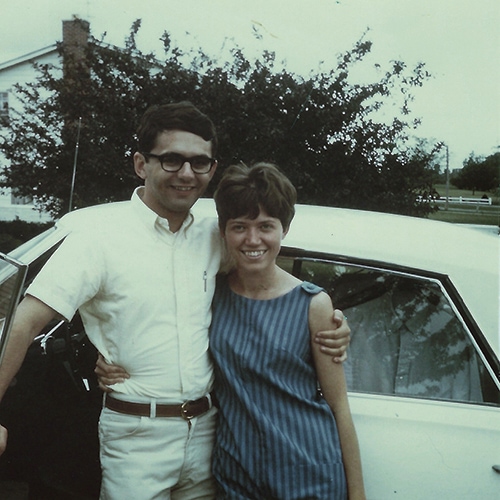
You married in 1968 in Flo’s hometown. Did someone pop the question, or did it just happen naturally?
Sid: It was natural. I told her, by the way, “I don’t have any money for a ring.”
Flo: I said, “Yeah, okay!” [Laughs]
Sid: Flo said, “Let’s buy our rings at Stix, Baer & Fuller [department store]—I have the employee discount!”
Flo: I did! [Laughs] These bands were bought with my employee discount. [They both hold up their hands.]
As Sid was beginning his career in Peoria, you were also kicking off your career with the University of Illinois Cooperative Extension Service as an adviser in home economics. Can you tell me about that?
Flo: Oh, that was wonderful. I got to work with all of the volunteer 4-H leaders and meet people in rural Peoria County. They were my people—I mean, I understood them! I really loved that job. I also did the textiles and clothing programs for the Tri-County area. I took a break and went to Illinois State University and earned my master’s degree in home economics, and then came right back. I had that job for about 10 years.
Sid, what were you doing for Caterpillar at that point?
Sid: I had a lot of different experiences. I did everything from manufacturing development, to being a supervisor on third shift, to working in the Met Lab [Metallurgical Lab] and quality assurance, and helping to plan the new engine factory in Mossville. While I was on an assignment for quality assurance, I had a boss who suggested it might be a good idea to become a Certified Quality Engineer, which required certain work experience, college-level study courses, and passing a daylong written exam. That wound up being fairly significant in my next couple of jobs.
I was invited to join a joint venture team with Martin Marietta [building materials company] in Denver, where we built a tractor for a mobile missile launcher. It never went anywhere because Congress refused to fund the missile, but we did build the tractor! That was one of the first vehicles Caterpillar built with rubber belts, because it had to go 50 miles an hour down a hard road. About the time that wound down, I was asked to join another joint venture team in Seoul, Korea, with Daewoo Heavy Industries. We were looking at developing a partnership to build a particular product line, and eventually a better option presented itself. So, we closed up shop and came home. Then a third opportunity came up to work in a startup in Monterrey, Mexico. That’s when Flo had to make the big decision about the fabric store.
Yes, Flo, tell us about your store. You had left the Extension job and opened up Flo & Friends Fabric Co. in 1978.
Flo: It was in the Field Shopping Center in Morton, and it is still there today as a fabric store! I love that it’s called The Quilt Corner. It’s been with multiple owners since I sold it. But isn’t that really something that it’s still there?
Besides the fabrics you sold, what else did your store offer?
Flo: We had a sewing school. We taught a lot of classes. That’s where education came in—it kind of fit into just about every job I ever did.
Sid: Flo is very modest, so I need to tell you a little story. She had the business eight years, and she always wore a beautiful dress. People would come in and say, “Flo, where did you get that dress?” And she would say, “The fabric is right over here, and the pattern is right over here!” [Laughs]
Flo: I had to be current. It was like being a mannequin in the store where you are working!
It must have been difficult to leave your business behind and move out of the country…
Flo: This was before fax machines, and we didn’t have reliable phone lines! I couldn’t have run it from Mexico, so I had to sell it. We didn’t stress over it too much. When we were in Mexico, I was like, What am I going to do now? I couldn’t get papers for a job down there. So I started teaching classes—sewing, clothing construction and quilting classes. People loved it. I had classes with four and five different nationalities, and there would be talking in various languages going on while I was teaching! We started a quilt guild, actually, which was a lot of fun.
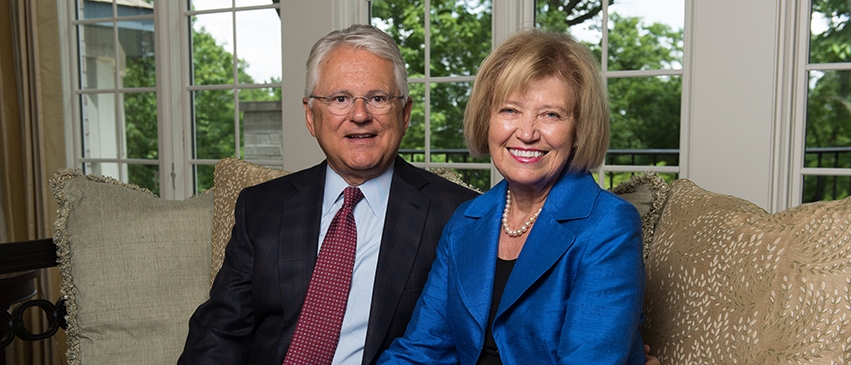
Sid, you held numerous positions at Caterpillar over the years, but your final role as Vice President and Chief HR Officer encompassed a great deal of responsibilities. Can you tell us more about this position?
Sid: I was responsible for a wide-ranging portfolio, including the global HR teams located in each plant and office around the world. Other areas included: Labor Relations, including negotiating contracts; Governmental Affairs, with offices in Springfield, Washington DC, Geneva, Beijing and other key countries around the world, with a focus on promoting free and fair trade; Corporate Security; Corporate Public Affairs, both external and internal communications; the Caterpillar Foundation; Corporate Real Estate; Building Design & Construction; Aviation Division; Safety and Environmental Department; Succession Planning; Employee Engagement; and Caterpillar University. I was fortunate to be able to work with so many different people all around the world. There were many opportunities to solve problems, and to help Caterpillar and Caterpillar people be recognized as a global leader. It was a fascinating and rewarding time to be an officer at a Fortune 50 company.
As you look back on your 41 years at Caterpillar, what stands out to you?
Sid: If you think about all of those different experiences, I feel like I had six or seven careers inside the same company. A couple of things stand out. One is that I was lucky enough to join a growing company at the right time. When I joined the company in 1968, sales were $1.7 billion. It was above $50 billion when I retired. That’s a 30-times increase. So, I made a good decision to come to Caterpillar.
I was also very fortunate in my timing. I found a company that promoted from within. I found a company that had a lot of great people doing great things all over the world. I’m grateful for how it unfolded. And I think that has influenced my feelings about charity. Because we wanted to do it kind of instinctively, we started doing it together very early on. But now we have the time and the opportunity to try to make a difference in a number of different areas. So it’s very natural for us to do that.
Flo, you eventually became an adjunct professor at Bradley University, teaching classes related to clothing construction, consumer behavior and historic costumes. What was it like to return to teaching?
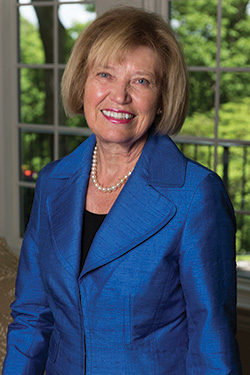 Flo: It was just so fun! I thoroughly enjoyed it. Some of these kids didn’t know which side of the sewing machine to sit on. In the first class, I said, “By the way, there are a lot of things on here that can hurt you and are sharp!” Because the serger could probably have taken off a finger if they weren’t paying attention. I said, “If you run the sewing machine needle into your finger—I know it happens! It’s happened to me twice!—I have a first aid kit up here and pliers.” Everybody just sort of blanched! But nobody did it. I think I scared them! [Laughs]
Flo: It was just so fun! I thoroughly enjoyed it. Some of these kids didn’t know which side of the sewing machine to sit on. In the first class, I said, “By the way, there are a lot of things on here that can hurt you and are sharp!” Because the serger could probably have taken off a finger if they weren’t paying attention. I said, “If you run the sewing machine needle into your finger—I know it happens! It’s happened to me twice!—I have a first aid kit up here and pliers.” Everybody just sort of blanched! But nobody did it. I think I scared them! [Laughs]
The two of you have a long history of charitable contributions. You both began volunteering with Junior Achievement the first year you moved to Peoria, which kicked off a lifetime of community involvement. Where did that drive come from?
Sid: I don’t think it’s an accident that we met in an activity where proceeds went to the United Way. One of my earliest memories of charity is how farmers would gather together to help somebody who was ill, or in some way incapacitated, to plant his crops. Twenty or 30 farmers would get together, and the crops were planted or harvested very, very quickly. I remember being impressed with that spirit of generosity. It was always in the back of my mind that if we ever had the opportunity, we would try to do some of the same. And so one of the earliest things we got involved with was an idea to bring Big Brothers Big Sisters to Peoria.
How did you manage to do that?
Sid: We did our research and found that we had to have an executive director and a connection with the national organization. For several years we arranged a mud volleyball tournament down on the riverfront. Businesses would pay to enter co-ed teams, and we raised enough money for about 90 days salary for our first executive director. We made an offer to a guy in Florida and he said yes. I was the founding board president.
You were also board president of the Peoria Symphony Orchestra and its Foundation; and Flo, you were president of the Peoria Symphony Guild and currently serve on the Foundation Board of Directors. What drives your love for music?
Sid: We both had some positive experiences growing up. I took piano lessons for eight years, dabbled with a couple of brass instruments, and wound up being a drummer. I was in the Iowa All-State Band and then the Iowa State Marching Band. We did so much exercise that we got physical education credits for being in the marching band! [Laughs] We also got to march in the parade in Mason City, Iowa, for the grand opening of The Music Man movie.
Flo: Oh, yes, this was in high school! It premiered there, because [composer] Meredith Willson was from Mason City, which is where I was born, actually. And I played trombone! They had all of the trombones out front.
Sid: We were both in that parade, but we didn’t know each other.
Flo: Music has always been important to both of us. Sid was far better at it than I was. We had tickets to the Symphony back when it was still at the Shrine Mosque. It was a night out, and it was something we looked forward to. We had some other friends who enjoyed going, too… so it was a big social thing for us.
Sid: I heard one of my Caterpillar colleagues say one time, “You have to have a symphony in a city like Peoria. How are you going to attract doctors if you don’t have a symphony?” Well, you could say the same thing about any professional people.
Flo: It means so much to a community to have something like that… It has endured here for so many years, and it’s just an amazing organization.
You recently funded the technology necessary to start WTVP’s new station, “WTVP REMOTE,” a collaboration with local educational institutions focused on remote education. It seems you often focus on projects that are collaborative. Why is that?
Sid: We like supporting collaborative efforts among the not-for-profits. That’s why we really like the PSO’s Soundbites series, which is collaboration between WTVP and the Peoria Symphony. It’s why we encouraged the Symphony to move into the open space at WTVP, because we were fairly certain that would help the collaborative ideas and efforts… and I think it has.
You also have a family foundation where you grant money to nonprofits on behalf of your family members. How did that come about?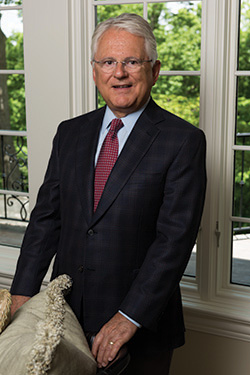
Sid: We were driving back from Chicago one day. I don’t know how the conversation came up, but since we don’t have any children, we wondered, What can we do to help the extended family learn about charitable giving?
Flo: Yes, to understand the power of philanthropy, and that it doesn’t take a lot of money to make a huge difference.
Sid: We designed this program from scratch. We have 13 nieces and nephews, and they have 26 kids. And nine years ago we said, send us an email on Thanksgiving Day—and there was a purpose to that, because we want them to think about being thankful. In that email, tell us who you would like a donation to be given to in your name. We’ll send $1,000 to the charity you select. That will go on year after year, and when your kids turn 12, they can begin to participate, too. And the most wonderful things have happened! We’ve had nieces and nephew say, “You cannot believe the wonderful dinner table conversations that have occurred as we’ve talked about, What are you going to do with yours?” And every year we publish an annual report. It lists everybody’s name, the charity they chose, and why.
I know you have a passion for travel. What was one of the first big trips you took together?
Sid: Our first big travel adventure was our fifth wedding anniversary in 1973. We bought a round-trip ticket to Mexico City from O’Hare with no hotel reservation.
Flo: Well, we had a travel book! [Laughing]
Sid: On our 25th anniversary we rented a Peugeot and drove all over France for three weeks.
Flo: Again, we only had two reservations. [Laughs]
Sid: We had a Michelin book. Our first night was in Dijon, and we said to the innkeeper, “What else should we visit?” And he said, “Where do you think you want to go?” I gestured, “Kind of in that direction.” “Oh,” he said, “I know a great place to stay!” And so, one day at a time, we just traveled all over.
Flo: We always have an adventure when we go anywhere. But what you learn about the people, the culture and the history… I mean, it is just an education. It is so important for people to do that, to understand our place in the world. And everybody is so proud of their country! They want to share it with you and show you all of the good things.
Sid: If you go with an attitude of respect, people can sense that, and they will tell you and teach you so much. And what a wonderful way to learn!
What legacy do you hope to leave with your family?
Sid: We hope it is a legacy of charity, thoughtfulness and a love of travel. If somebody says someday that they were careful with what they contributed to, but they were able to make a difference in a positive way in the communities where they lived—I think that would be wonderful. You can’t predict the future, but you can impact the present. And I’ve always believed that you make the future by working on the present.
Flo: With an eye to the future!
Sid: We’re all influenced by others. My grandfather lived to be 97. One time, I said to him, “Bye grandpa! Have a good day.” He said, “Wait a minute. Have a good day? That’s way too passive. You want to be in a position of influencing people in a positive direction. Ask them to do a good day. Not just have a good day.”
Hearing all of these stories, it seems like you are a great fit for one another!
Flo: We are. That’s why it’s been 52 years! We’re lucky. PM


